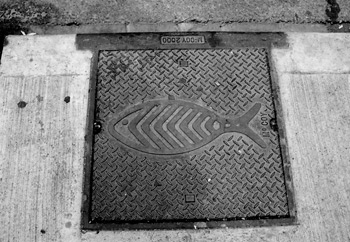Cast iron beauties article and photos by Suzan Krepostman : : : : : : : They seem inconspicuous enough, but only because we’re not used to looking. Utility covers or sewer maintenance hole covers (commonly known as manhole covers) come in many different shapes, sizes, patterns, and designs. The very first decorative ones I noticed were in Hoboken, New Jersey, and in New York City, when I was graduate student. I found myself living in a neighbourhood where dog owners ignored “stoop and scoop” by-laws, causing me to keep my eyes on the pavement. I began taking pictures and soon learned that my quirky hobby was in no way unique. Utility covers have been documented in dozens of personal websites, local historical society exhibits, and art books, cataloguing their unique designs around the world. They have been the subject of city-funded art projects and competitions in North America, Europe and Asia. Their patterns have been used to create furniture, lighting, and jewelry. Surprisingly, they have even been the target of hundreds of thefts worldwide, in places where scrap metal is scarce.
So how does Toronto fare in the realm of public-works-as-art? The truth is that Toronto-area covers are not nearly as interesting as they could be. Maybe it has something to do with the fact that one-third of the year our roads are covered in snow, slush, and ice, so they’re often just not visible to us. Metro Archives has city engineers’ files relating to the purchase of manhole covers dating back to early in the last century. Mostly bureaucratic in nature, the files offer little in the way of depictions of manhole covers past. A better way to go about finding local gems is just to get out there and walk your neighbourhood streets. It was during my strolls through downtown that I came across two shining examples of cast-iron beauty. The first is a fish on a square utility cover on Baldwin Street. The second is a star stamped on top of a round manhole cover decorated with simple concentric circles at Church and Shuter. Although they are simple designs, their charm is in their departure from the everyday — they give us a reason to look more carefully at our surroundings. Currently, contractors responsible for various public works projects throughout the city choose utility cover suppliers from amongst the lowest bidders. The only standardization is in the dimensions of the covers, whereas the designs are dependent on the foundries that manufacture them. Toronto’s covers still have a long way to go before becoming works of art or inspiring large-scale competitions, as they do in Vancouver, New York, and Japan. In Vancouver, the Office of Cultural Affairs sponsored a manhole cover design competition in April 2004. Open to all people residing, working, or attending school in the City of Vancouver, the results were stunning — from children’s stick figures to elaborate aboriginal designs. These days, there are unconfirmed reports of a new design for Toronto covers to be unveiled with the city logo on it, but perhaps, following in Vancouver’s footsteps, our city might be better served by the offerings of local residents and artists, whose creativity might bring some fun to our roads and sidewalks. |
|
spacing.ca || contact || subscribe || in this issue || stores (c) 2005 Spacing Publishing |


